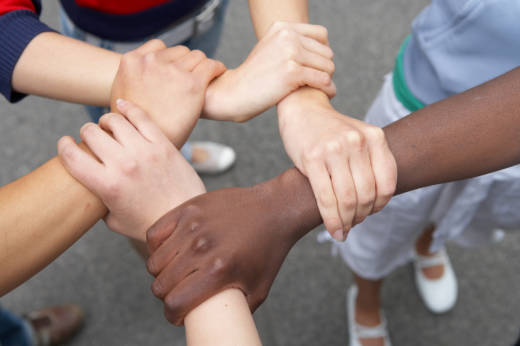“We know that kids readily form in-group biases,” said Skinner. For example, if you take a group of kids and put half in the green group and half in the red group, kids will prefer members of their color group “even if it’s an entirely made-up thing in the lab.”
Knowing this propensity to favor one’s “in-group” -- and knowing that children absorb nonverbal cues from adults as they try to understand other groups they encounter -- the question becomes: What are the messages we are communicating about people from different religious, racial or ethnic backgrounds?
As the study notes, many preschoolers in the United States live in fairly homogeneous communities, limiting their exposure to different groups and their “opportunities to observe positive nonverbal signals demonstrated toward such people.” Because of this, even brief exposure to “biased nonverbal signals against one or two out-group members could result in generalized bias against that group.”
Conversely, adults can draw upon children’s sensitivity to social signals to intentionally mitigate bias. Here are four strategies.
Examine Your Nonverbal Messages
“We need to be aware of the messages we are giving to kids,” said Skinner. “How did I just interact with that person in the grocery store? If that’s the only person my kid has ever seen wearing a hijab, what did they learn from that interaction?” When children have limited contact with members of different groups, they form understandings based on these small pieces of information. With this in mind, said Skinner, “we can capitalize on using positive nonverbal signals.” Children will watch our body language as we interact with others in the checkout line or at the park -- so warm smiles, eye contact and polite interactions can help children open themselves to diverse groups.
Examine Your Verbal Messages
Adults can pay attention to the language they use to describe groups of people. According to one study, young children were highly susceptible to explicit messages about groups -- even when that message contradicted their experiences. When kids were told that a particular group would be “mean” to them before they interacted, that message influenced how they perceived the interaction -- even when it was objectively positive. In other words, said Skinner, “The message was more powerful than their experiences.”
Expand Your Circle of Friendship
For adults who want to help children minimize bias, “diversifying your friendship network doesn’t hurt and has the potential to help,” said Skinner. One study found that mothers’ participation in interracial friendships was predictive of lower racial bias in children. In these friendships, said Skinner, “parents model and reinforce positive nonverbal messages” for young children. These interactions tell them, on a repeated basis, that “people of this group are to be trusted, hugged and smiled at.”
Use Books and Media To Prompt Conversation
If children do not directly interact with people from a variety of groups on a regular basis, adults can use books and media to intentionally open up conversation about other religious, ethnic and racial groups, tapping children's empathy and imagination. In one study, 5- and 6-year-olds who were asked to imagine interacting with a child with a physical disability “showed reduced intergroup bias" and "more positive intended friendship behavior towards the disabled.” Another study out of the United Kingdom found that students who read “friendship stories” featuring English children and refugees had a more positive attitude toward refugees -- particularly when these stories were paired with conversations about how these friends were similar (e.g., attending the same school) and how they were different (e.g., born in different countries).
Such efforts, of course, require adults to examine their own biases and to be aware of the overt and subtle cues they are sending to children. “If there is a group of people you are uncomfortable around, children will certainly pick up on it,” said Skinner. “And if that is the only piece of information they have about that group, that’s pretty powerful.”


